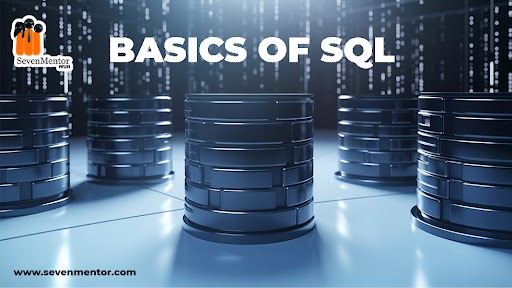Basics Of SQL
Structured Query Language (SQL) is the foundation of database management and a vital tool for anyone working with data. Whether you’re a seasoned database administrator or just starting out in data analytics, understanding SQL is crucial. In this comprehensive guide, we’ll delve into the essential aspects of the Basics Of SQL, from basic syntax to advanced querying techniques. Unlock the power of data with SQL Training in Pune! Join SevenMentor Training Institute’s expert-led courses to master the art of SQL, from fundamentals to advanced techniques.
- Understanding SQL Basics
- What is SQL?
Definition and purpose
Importance in data management
- Data Types and Databases
Exploring common data types (integer, text, date, etc.)
Introduction to database structures (tables, rows, columns)
- Creating and Managing Databases
Creating a database
Altering databases
Dropping databases
- Querying Data with SELECT
- The SELECT Statement
Syntax and basic usage
Retrieving specific columns
- Filtering Data
WHERE clause and comparison operators
Logical operators (AND, OR, NOT)
- Sorting and Ordering
ORDER BY clause
ASC vs. DESC
III. Manipulating Data
- Inserting Data
INSERT INTO statement
Adding multiple records
- Updating Data
UPDATE statement
Modifying multiple records
- Deleting Data
DELETE statement
Removing specific records
- Working with Joins
For Free, Demo classes Call: 020 7117 1500
Registration Link: Click Here!
- Understanding Joins
Inner joins
Left joins
Right joins
Full outer joins
- Using Aliases
Creating aliases for tables
Improving query readability
- Complex Join Scenarios
Self-joins
Cross joins
Non-equi joins
- Aggregating Data
- Aggregate Functions
SUM, AVG, MIN, MAX, COUNT
Using aggregate functions in queries
- GROUP BY and HAVING Clauses
Grouping data
Filtering grouped data
- Subqueries and Derived Tables
- Understanding Subqueries
Nested queries
Correlated subqueries
- Derived Tables (Subquery in FROM Clause)
Creating and using derived tables
Benefits and use cases
VII. Views and Indexing
- Creating and Using Views
Definition and purpose of views
Creating and querying views
- Indexing for Performance
Index types (B-tree, Hash, etc.)
Creating and managing indexes
VIII. Transactions and Data Integrity
- Transactions and ACID Properties
Understanding transactions
ACID properties (Atomicity, Consistency, Isolation, Durability)
- Ensuring Data Integrity
For Free, Demo classes Call: 020 7117 1500
Registration Link: Click Here!
Constraints
Triggers for data validation
- Advanced SQL Techniques
- Window Functions
OVER() clause
Partitioning and ordering in window functions
- Common Table Expressions (CTEs)
Syntax and advantages
Recursive CTEs
Do watch our Channel to learn more: Click Here
Conclusion
Mastering SQL empowers you to efficiently manage and analyze data, making it an indispensable skill for anyone involved in data-related tasks. This comprehensive guide has provided you with a solid foundation in SQL, covering everything from basic syntax to advanced techniques. With practice and hands-on experience, you’ll be well on your way to becoming a proficient SQL user, ready to tackle complex data challenges. So, roll up your sleeves, fire up your favorite database management system, and start querying!
Author:-
Anil Giri
Call the Trainer and Book your free demo class for SQL now!!!
© Copyright 2020 | SevenMentor Pvt Ltd.

